A Methodist
Accountant In India
Written July 15, 2001
|
|
A few years before I was born, my father, Vernon Thomas, was on a good career path. But Pearl Harbor threatened to change all that, and he soon found himself in an exotic land. In 1993, he told his life story to Harold Simmons for Harold's "Meet the Veteran" feature in the November 3 edition of the Richwood Gazette. |
"Vernon was the second of seven children born to Hubert and Lydia Thomas. He arrived on October 30, 1909, at Livermore, McLean County, Kentucky.
"The young lad attended school in his home town of Livermore until the end of his junior year. The family moved to Glasgow, Kentucky, where his father bought a restaurant in 1925. Vernon helped in the business there and graduated from Glasgow High School in 1926.
"He then went to work for his uncle, also in the restaurant business, at Paris, Kentucky, in 1927-28, before entering Business School at Bowling Green, Kentucky, for a six-month course in the General Motors accounting system.
"Vernon was at Falmouth, Kentucky, from 1929 to1938 as manager of a Chevrolet dealership, prior to taking a job at another dealership in Cambridge, Ohio, selling Chevrolet, Olds and Cadillac."
In 1938 he met my mother; in 1940 they were married. But with the news of Pearl Harbor and America's entry into World War II came the realization that Vernon would probably have to go into the service.
It was more than a year before his name came up in the draft. He was inducted on Saturday, April 10, 1943, and sworn in a week later at Fort Hayes in Columbus, Ohio. (He attended a Palm Sunday service at Fort Hayes the next day.) The following Friday he took a train to Indianapolis and Fort Benjamin Harrison for basic training. (He attended an Easter sunrise service there on April 25.)
|
|
|
INDIANAPOLIS, MAY 1943 |
Because of Vernon's previous education and experience, he entered the Second Finance Training Battalion at Fort Benjamin Harrison. Here's a letter he wrote to his wife's parents back in Cambridge on Sunday, June 13, 1943.
Dear In-Laws:
There is an old saying that it's better late than never, so I'll answer your letter even if I am rather late.
First, I want to thank you for thinking of me when Ann came over last weekend and sending along some eats. I really did enjoy the feed very much, as Ann has probably already told you.
The weather here during the last few days has been very hot, giving us a sample of the Middle West heat. Since I've been here I have seen some terribly disagreeable weather. During the basic training it rained all the time, and we had to be outside. Now it is very hot, and we have to be inside all the time or at least most of the time.
We get up every morning except Sunday at 5:30 and have to clean the barracks and go eat and then march to school and be there at 7:30. Classes start at 7:30 and we have a break of ten minutes out of each hour, these breaks coming at 8:20, 9:20, and 10:20, and then at 11:25 we march back to chow.
We return to school at 1:00. During the afternoon we only have one break, which comes at 2:30. After our break we have one period of fifty minutes, and then we go out on the parade grounds and drill for half an hour, and then take exercise for about half an hour, and then march back to the barracks and to chow. Then at 6:30 we have to go back to school for just one hour, and then we are finished for the day at 7:30.
We make three round trips per day to and from school, which is about one mile each way, and that is a lot of walking. Then on Saturday afternoon, instead of going to school, we take a hike. Yesterday afternoon we went on a five-mile hike, but that doesn't seem far at all, since we have marched over ten miles in one afternoon and are used to a lot of walking anyway in going to and from school. I don't know how much I weigh, but I have lost some of my waistline. I sure do feel good physically. I guess the exercise is really good for me.
Well, I understand you have finally got your garden planted, so have the roasting ears ready and tomatoes too for about the last of July. I will be starved for them by that time, and if the War Department don't change their mind, I will get to come home at about that time. I won't plan too much on getting home so that I won't be disappointed if they do change the order.
Well, news is scarce, so I'll sign off for this time. Don't work too hard, and I'll be seeing you.
Sincerely,
Vernon
He completed the course in August and was sent on to Camp Shenango in western Pennsylvania. His wife took a room in nearby Sharon, Pennsylvania, so they could be together. To read some of her letters about that experience, click here.
During his five months of waiting at Camp Shenango, Vernon served as a runner between the Post Office and the various camp offices, delivering orders and dispatches.
Finally his own orders came through: he would be sent overseas, to an undisclosed location. On January 11, 1944, at Norfolk, Virginia, Vernon joined about 6,000 other soldiers and nurses on the ocean liner Empress of Scotland.
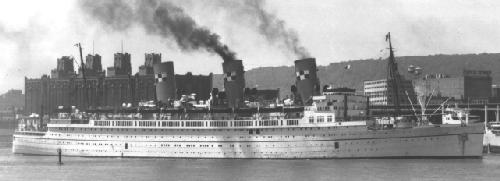
EMPRESS
OF SCOTLAND (UNDATED PHOTO)
The troops learned that they were headed to India. This British colony was part of the China-Burma-India Theatre or CBI, a major Allied operation against the Japanese who were occupying parts of continental Asia. In particular, India was a staging point for supplies being sent to the Chinese Nationalists under Chiang Kai-shek.
|
UPDATE In 2005, Ken Beyer of upstate New York happened across this article. His father was on the same voyage as mine! Charles Beyer was also en route to India, where his unit (22 Air Depot Group, 97th Repair Squadron) would ultimately be stationed at Kharagpur with the 20th AAF 58 Air Wing servicing B-29's. Ken is working on a project in memory of his father. But, he writes, "Trying to reconstruct the units that made the trip over has been difficult to say the least, as troop passage records were all destroyed in the 1950's. Blackout regulations kept the men cooped up in the hot, stuffy, and engine-noisy lower 'D' deck at night, but they were allowed some freedom during the day topside." |
Zig-zagging across the Atlantic Ocean to avoid German submarines, the Empress of Scotland sailed south across the equator on January 19. A week later she stopped in Cape Town, South Africa, to refuel; the troops briefly went ashore. Then it was across the Indian Ocean to Bombay.
A quick geography lesson: Bombay (now known as Mumbai) and Karachi are large cities on the west coast of the Indian subcontinent, while Calcutta is a large city in the east. Vernon would eventually go to Chabua on the eastern tip of India, near its borders with Burma (now Myanmar) and Tibet.
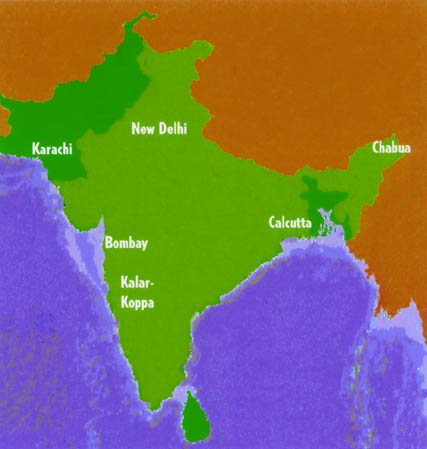
The parts of India shown in darker green would eventually become the independent nations of Pakistan (west), Bangladesh (east), and Sri Lanka (south). The nation of India has its capital at New Delhi.
The other town labeled on the map, Kalar-Koppa, is a small, poor village. A few years after the war, my father's financial support made possible the construction of a church there. For that story, including B.R. Isaiah's letter to my mother about Christianity in India, click here.
Having arrived in Bombay on February 8, Vernon disembarked from the ship on February 10, going ashore to a British installation for a couple of days. Two days later, he was on a train headed east for Calcutta, two thousand miles away.
In a notebook, he recorded a few observations and a few tips. "Sat., Feb. 12, '44 — Leave Bombay 8:45 PM. Grass Dead — Stop 2 Hrs Breakfast — Goats. No Fences.
"Melted paraffin on inside of waste baskets to prevent rust. Thumb tacks on lower corners of picture frame prevents dust mark on wall."
The rail cars arrived at Camp Angus outside Calcutta on February 16, 1944. Now at last Vernon was allowed to write home that he was "somewhere in India."
He would be at Camp Angus for more than five weeks, doing very little work, awaiting assignment. But to fill the time, he did write a lot of letters. Nearly 60 of them from this period have survived. To read excerpts of his impressions of India, click here.
Finally the orders came through, and on March 24 Vernon departed for Chabua, in the Assam Valley. Men who had been in Assam for a couple of years already would be replaced by his unit. On the week-long journey, they served as train guards, drawing their drinking water out of the locomotive.
According to a Time-Life Books story, this trip was on "an ancient railway between Bengal and Assam known to Americans as the Toonerville Trolley. Built to carry tea down from the Assam highlands, the railway changed gauge three times, and its freight had to cross the unbridged Brahmaputra — one of Asia's great rivers — by barge."
Some of that freight consisted of military vehicles that had to be driven from one set of rail cars to another whenever the track changed gauge. Then when they reached Assam, the vehicles were cut in two. Each half was loaded into an airplane and flown to China, where the halves would be welded back together.
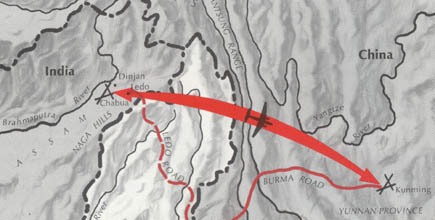
TIME-LIFE
BOOKS
Near Chabua was the airfield from which C-46 and C-47 transports departed to "fly the hump" over a spur of the Himalayas, 500 miles across northern Burma to Kunming in China. It was a hazardous trip, and scores of planes went down.
As an alternative, Army engineers were also in the area working on the Ledo Road, which would connect with the Burma Road to form a land route to Kunming.
Other personnel in the area included Merrill's Marauders, as well as OSS agents working out of Nepal.
It's easy to overlook one detail: all these people had to be paid. And my father, with his background in accounting, handled the money.
"Being assigned to the 290th Finance Disbursing Section of the China-Burma-India Theatre of Operations," he told Harold Simmons, "I picked up mail, money and special orders from headquarters for that area. About one million dollars in rupees went through the office each month. MP's rode the jeep to and from the bank at Debrugarh. I was the driver."
The troops were paid in rupees (the local Indian currency; one rupee was worth about 25 cents). A man coming in from China for R&R might have American dollars; he would have to convert them to rupees.
The pay for pilots was good. My father told of one air crew that was caught bootlegging cigarettes to China; the captain was fined $5,000, a considerable sum in those days, but was able to pay it off within a couple of months.
|
|
Here's what the town of Chabua looked like in 1945. For more color pictures of my father's stay in India, click the button below.
|
The camp outside Chabua was a former tea plantation. Tea leaves were picked, then dried by putting them on slats that formed the floors of a barn-like structure. Then the leaves were "tromped on a concrete floor," according to the Simmons article, and the stems thrown out.
"Our little nasha (hut) for eight had a thatched roof; the sides were of split bamboo. The office was also built that way, except that it was much larger with an upper floor to sleep officers."
|
Vernon bought a mynah bird from an Indian boy for one rupee. "The bird made friends easily," he recalled, "and would sit on my shoulder wherever I went, even to the mess hall. It often had access to the place where we slept. "They made me get rid of my pet. They considered it a nuisance. So I gave it to a native who took it away. "Writing letters, walking and going to movies were about the only pastime activities; there wasn't much else to do." |
|
|
Another encounter with the local wildlife: catching this lizard by the tail. There's no word as to what was done with it. The company of 25 had native cooks who prepared the food, but the meat came by ship from Argentina, and all other food was shipped in from the West. The Americans were allowed to buy bananas, but only from men with the proper badges. |
|
The fighting ended on August 14, 1945, and Japan signed the formal surrender terms on September 2. The photo below, according to a notation on it, was taken on V-J Night (Victory over Japan). My father is seen in shadowy profile on the extreme left. The men seem to have interrupted their celebration to watch a movie, perhaps a newsreel about the end of the war.
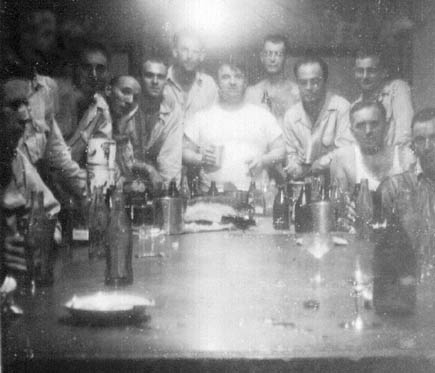
It didn't take long to send the troops home. Vernon closed out his work with the 290th on October 8, and one week later, the airplane shown below carried him from Chabua across the subcontinent to Karachi.
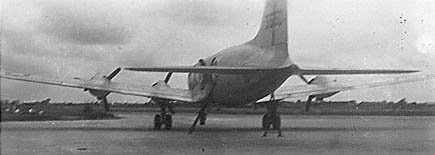
|
|
After three weeks in Karachi, he boarded the USS Richardson, along with over 5,000 other veterans on their way home.
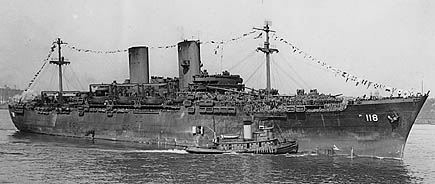
USS
GENERAL W.P. RICHARDSON (UNDATED PHOTO)

LOADING
THE RICHARDSON, NOVEMBER 4, 1945
The troop ship sailed through the reopened Suez Canal and the Straits of Gilbraltar, finally docking in New York in the late evening of November 24 after passing the lighted Statue of Liberty. "I went topside to see it," my father remembered. But not that many joined him. "I thought more people would be crowding the rail."
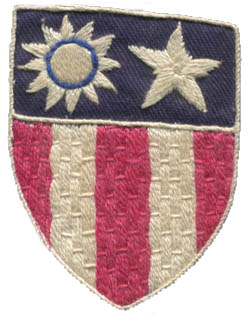 Everyone
was in a hurry to get home. On November 26, Vernon departed
Camp Kilmer in New Brunswick, New Jersey, on his way to Fort
Indiantown Gap in Pennsylvania. There on November 28, 1945, he
received his discharge as a Technical Sergeant (T-4) with the
Asiatic-Pacific, Good Conduct and Victory ribbons, as well as this
CBI patch.
Everyone
was in a hurry to get home. On November 26, Vernon departed
Camp Kilmer in New Brunswick, New Jersey, on his way to Fort
Indiantown Gap in Pennsylvania. There on November 28, 1945, he
received his discharge as a Technical Sergeant (T-4) with the
Asiatic-Pacific, Good Conduct and Victory ribbons, as well as this
CBI patch.
You're invited to go to the related articles which were mentioned above. Once again, here they are:
On
the Homefront
As Vernon
prepares to head overseas, his wife writes to her mother.
B.R.
Isaiah
On India's
religions, the changes brought by Christianity, and a church that our
family built.
Dearest
Ann
Excerpts from
my father's letters from Calcutta in 1944, including examples of V-Mail.
India
1945
Color photos.
Also see an article about Memorial Bricks.
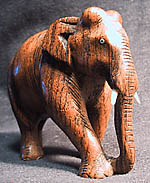
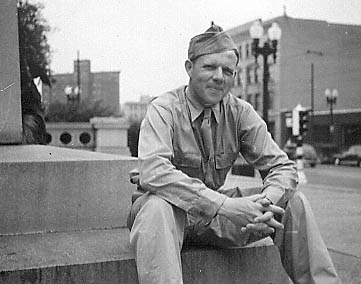
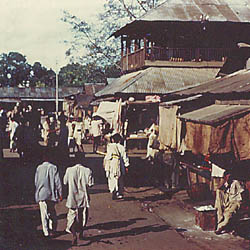
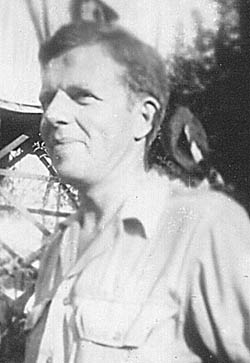
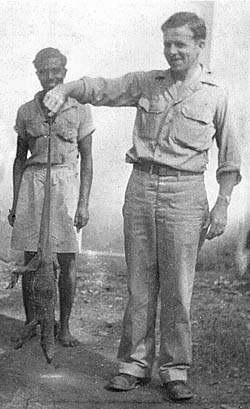
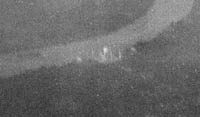 "We
flew over the Taj Mahal on our way," he recalled. "It
was beautiful — especially the dome." Vernon snapped
this picture of the monument along the Yamuna River.
"We
flew over the Taj Mahal on our way," he recalled. "It
was beautiful — especially the dome." Vernon snapped
this picture of the monument along the Yamuna River.